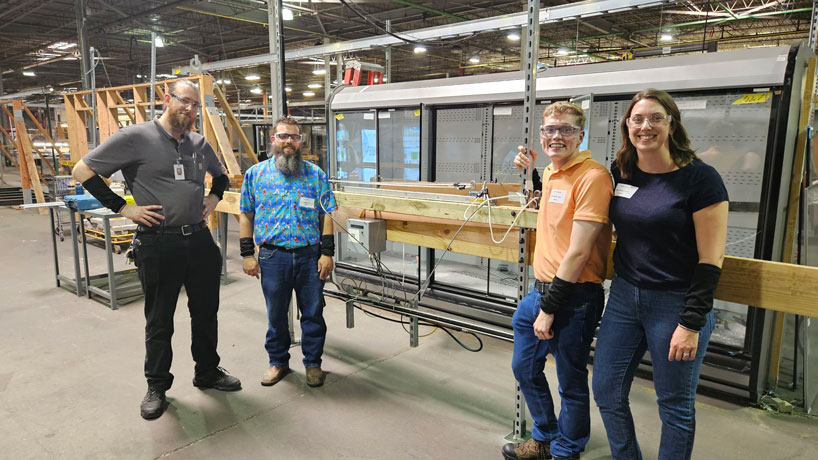
(From left) William Todd, Seth Flamm, Alexander Clark and Briana Kagy, all mechanical engineering students in the UMSL/Washington University Joint Undergraduate Engineering Program, created a device to help the Hussmann Corporation test commercial refrigerator doors as part of their capstone project in ME 4110 Mechanical Engineering Design Project. (Photo by Wendy Todd)
The Hussmann Corporation, among the largest manufacturers of display cases and commercial refrigeration systems in the United States, has for years been trying to solve the same problem.
The company has been challenged to develop a device to test doors on commercial refrigeration units that won’t wear out too quickly, and it recently sought help from a team of mechanical engineering majors in the University of Missouri–St. Louis Joint Undergraduate Engineering Program.
For their capstone project in the ME 4110 Mechanical Engineering Design Project course, Alexander Clark, Seth Flamm, Briana Kagy and William Todd were tasked with developing a better apparatus that could withstand wear and tear longer, and they spent the past month of the summer creating an alternative. Their new device is a series of ropes connected to an apparatus that moves back and forth along a slide to pull the doors open and release them.
The students and their professor, Mark Jakiela, the mechanical engineering design program director in the joint engineering program, met earlier this month on a warm afternoon at a warehouse in Bridgeton, Missouri. With the constant “swooshing” sound of doors on commercial refrigerators opening and closing in the background, they tested their device to see if they had solved the problem.
The early indications were positive, but six months of testing will offer the final result.
The device is connected to a counter that will record the number of cycles it makes with the average being 11,000 per day. The goal is 2 million cycles, which would equate to 6 months.
The current device Hussmann uses lasts about 10 months, but the students’ device is overall more cost effective. At the end of the experiment, if the students’ device is successful, it or parts of it can be adopted by Hussmann to use for testing.
“Having a more cost-effective solution that runs longer is critical,” said Cody Schollmeyer, an UMSL alumnus and engineering manager at Hussmann. “But we don’t always have a lot of engineers to sit here and work on this because we already have something that works. It’s expensive. So that’s what these guys can do for us – come up with a more optimized version of what we need.”
Collaboration was at the center of the project.
“We all came up with a unique concept through discussions with both Hussmann, our professors and each other, and picked out the winner,” student and Hussmann employee William Todd said. “But we also combined some pieces from the other concepts that we liked with our overall concepts.”
The Mechanical Engineering Design Project was a valuable experience for students. Briana Kagy, who is pursuing engineering as a second career after working in the arts and doing printmaking, found the practical nature of the task to be helpful.
“I think the purpose of the class overall is to mimic the design and fabrication experience in the industry,” Kagy said. “So it’s really like the class overall takes you through all the steps from coming up with your design problem to your initial concepts, your BOM, risk analysis – all of those things that you should do to build your equipment.”
Another participating student, mechanical designer Alexander Clark, who works at Roeslein & Associates Inc., agreed that the project emulated real-world scenarios which call for flexibility and adaptability.
“I think field experience is always valuable,” he said. “Things don’t always go as planned. One thing is we designed it for a five-door left-hand case, and as soon as we walked in, we saw it was a four-door case, and it was French doors.”
But the students weren’t thrown off and still found a way to improve upon the current Hussmann testing device.
Jakiela was very impressed with the work his students completed. He’d only heard about it or viewed photographs. But seeing it in person demonstrated the team’s knowledge and ingenuity.
“This was a very strong group of students,” he said. “For almost all of them, this is the final course in their program. After this, they’re engineers. It was gratifying to see them realize this was a chance to ‘leave their mark’ and show what they can do. There were ups and downs throughout the term, but in the end, every project worked.”
A great deal of the team’s success was having taken a previous mechanical design and machine elements class with Jakiela, which taught them how to integrate customer needs into their work.
Teammate Seth Flamm, who is a manufacturing engineering analyst at Boeing, learned how to ask the right questions of the customer to ensure an effective design.
“This is why you ask certain questions of the customer,” he said, referencing the outcome of the project. “To make sure you meet their needs and to make sure you design something that is not only going to work but also works to a certain standard. We could have just done anything, but we had certain specifications we needed to meet through talking to the customer.”
Todd, along with his teammates, is very proud of the work they did and feels satisfied that they’ve made an impact at Hussmann.
“We’re all really excited that they’re probably going to keep using our system,” Todd said. “So that’s our big takeaway from this class. Even if they don’t use exactly what we’ve done, they’ll use pieces of that, so it’s cool to leave a legacy with your capstone project.”














